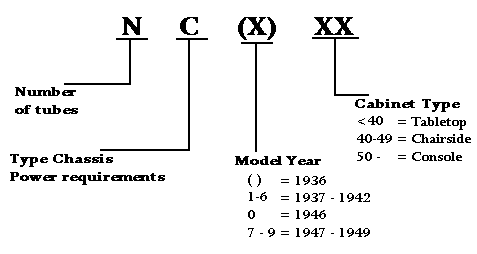A Guide to Zenith Model Numbers
The Black Dial Era (1936-1949)
by Blake Dietze
Thanks to www.radioremembered.org for
finding this helpful bit of information, I
highly recommend a visit to this site!
This article appeared in the Winter 1996 issue
of The Reproducer, the journal of The
Vintage Radio & Phonograph Society, and is
reprinted here with permission of Blake Deitze.
Two important points need to be covered for a
better understanding of the model numbering scheme.
First; the big round "airplaine" dial
that was introduced by Zenith came prior to 1936.
This article will deal with the "Big Black
Dial" radios and the numbering scheme which
was introduced in late 1935 for the 1936 model
year. It is my belief that the year used to date
a radio should track with the "model year" and
not with the actual production date. I offer an
analogy: An automobile may be produced in 1995,
but will for ever more be referred to by "its" model
year (1996). Second and equally important; Zenith
included every vacuum tube in the tube count including:
ballast, regulators, and cathode ray (magic eye)
tubes.
Beginning in 1936, Zenith introduced a new model
numbering scheme. Given the model number, a repairman
could easily determine the number of tubes, the
type of chassis, power requirements, model year,
the type of cabinet, and ever where in the line-up
the radio was found. Lets start by examining the
left or leading side of the model number using
a "Walton Radio" as an example (12S232).
The first digit(s) will be the number of tubes,
12 in this case, 11 on the chassis plus an "eye" tube.
The number of tubes will be between 4 and 16 (the
25 tube Stratosphere, first produced in
1935 remained as the model 1000 throughout production).
The second segment of the model number revels
the chassis type and the power requirements. Research
indicated that there were 17 initial categories,
each represented by a single letter. Many of the
letter designations were used to describe Zenith's
line of automobile radios, which I do not intend
to discuss in this article. Listed below are the
letter designations that were used to describe
the Zenith home radios:
| A - 110 volt AC, All
Wave
| M - Automobile (subcatagories
inc:
F, H, L, M, N, W, X)
|
| B - 6 volt farm set
| P - 110 volt AC, broadcast
and
police bands
|
| D - AC/DC chassis, 110
volt
| R - 110 volt AC, broadcast
only
|
| F - 2 volt farm set
| S - 110 volt AC, broadcast
police and shortwave
|
| G - 110 volt AC/DC plus
battery
| T - 110 volt AC
|
| H - 110 volt AC with
FM
| U - 110 volt AC, broadcast,
shortwave
and ultra- shortwave
|
| J - 110 volt AC or 6
volt DC
| V - 6 volt farm set with
synchronous vibrator
|
| K - Battery type farm
or portable
| X - 32 volt farm set
|
| L - Standard broadcast
plus shortwave
|
|
The last 3 digits get a bit more complex. The
last two or three identify the cabinet type, and
the relative placement in the line-up ($costs$).
If the letter designation is followed by a two
digit number (IE. 6V27), the radio was built for
the 1936 model year. Some collectors will force
a zero at the beginning, (IE. 6V027), this however
is not correct and may lead to confusion later
on. If the letter designation is followed by a
three digit number the radio was built in later
model years. If the leading number is 1 (IE 5S128)
the radio was built for the 1937 model year. In
our example of the 12S232, the radio was built
for the 1938 model year. This scheme holds true
for radios built through 1942, when Zenith halted
civilian radio production to enter the war effort.
Zenith did not produce radios for the general public
again until late 1945, and were sold as 1946 models.
An interesting side note, Zenith did continue to
produce civilian hearing-aids throughout the war
years.
The two trailing digits of the model number describe
the cabinet and the relative placement in the cost
line-up. The higher the last two digits within
their range, the higher the position in that years
model line, or more simply the higher the retail
cost of the radio. As for the cabinet, the ranges
for the cabinet styles are as follows:
| 00 - 30 indicates a table model
|
| 40 - 49 indicates a chairside model
|
| 50 - indicates a console model
|
In our example, the 12S232 would be a 12 tube
table model built for 1938. The chassis would have
3 bands including broadcast, shortwave and police
and was 110 volt AC powered. The collector would
also note that the cabinet number falls very high
in its range (00-39) indicating a rather expensive
cabinet design.
Should you ever come across a Zenith radio which
uses this model numbering system and it has a suffix
letter after the model number itself, you have
obtained an export model. The suffixes included:
| E - Export (auto radio)
|
| T - Export (other radio)
|
| TA - Export, 25 cycle (all voltages)
|
| TB - Export, 60 cycle (all voltages)
|
TC - Export, 50/60 cycle
(95, 117, 150 VAC)
|
Model Number Scheme

|

